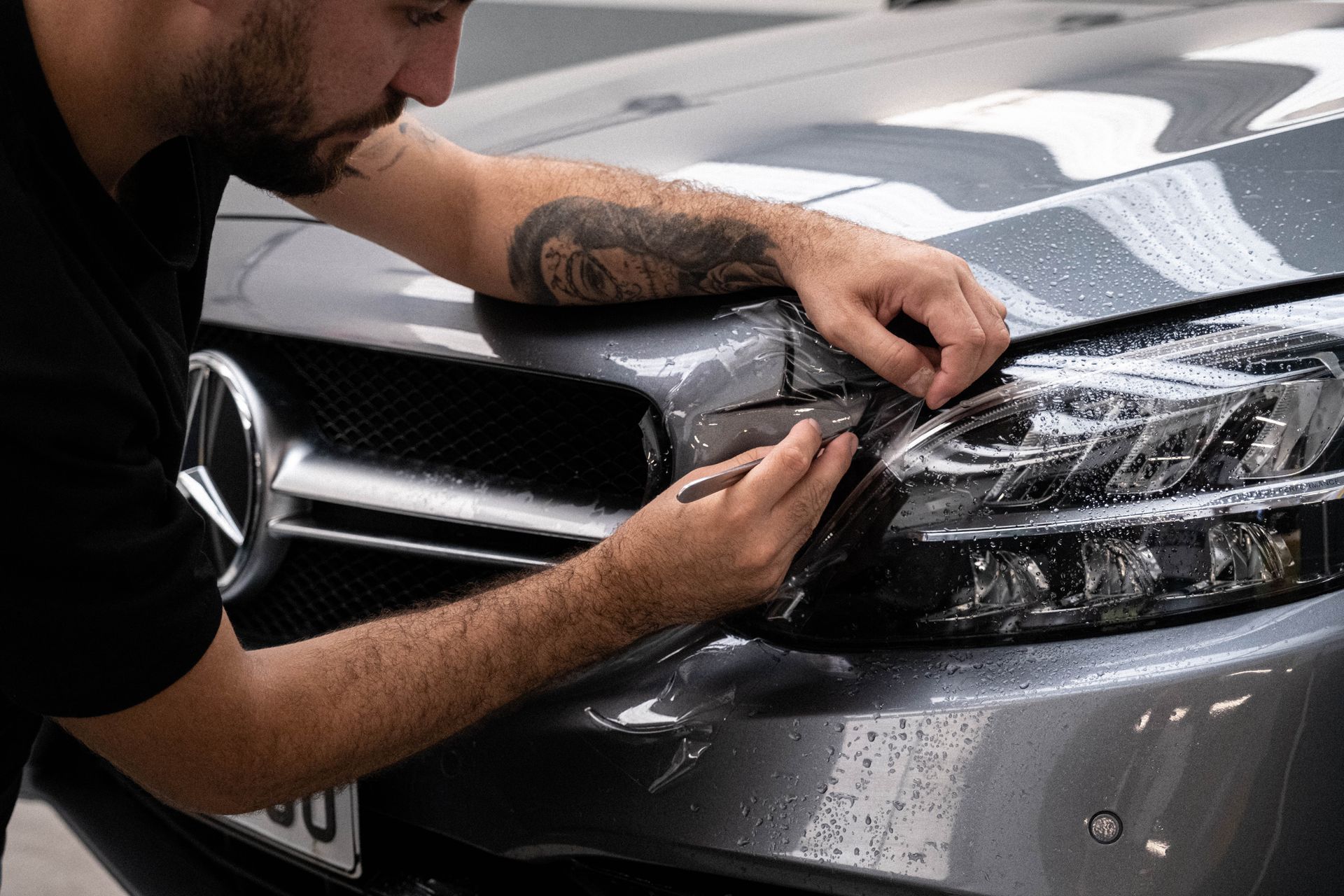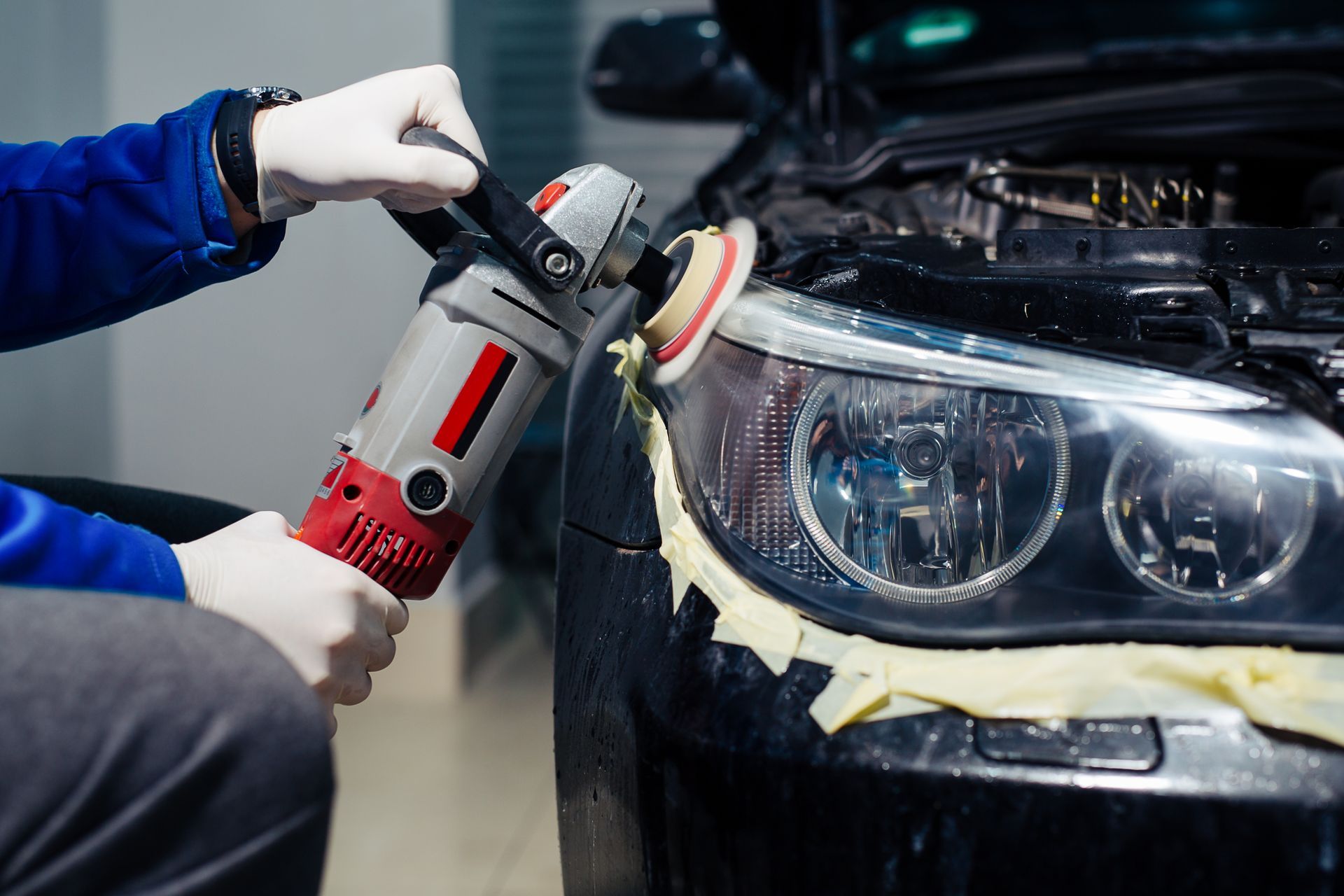Expert Foggy Headlight Restoration Solutions
Methods of Headlight Restoration
Our headlight restoration services employ various methods to ensure optimal clarity and longevity for your headlights. Here are the three primary techniques we utilize:
- Traditional Sanding and Polishing Methods: This method involves carefully sanding the surface of the headlight lens to remove the outer layer of oxidized or yellowed plastic. We then follow up with a series of finer sandpapers to smoothen the surface further. After sanding, a polishing compound is applied to restore clarity and shine to the lens. This technique effectively eliminates surface imperfections, scratches, and discoloration, providing a clear and bright illumination for safer driving.
- Chemical Cleaning Agents for Headlight Restoration: We utilize specially formulated chemical cleaning agents designed to break down and remove oxidation, dirt, and grime from the headlight lens. These solutions are applied to the surface and allowed to penetrate, softening the buildup and making it easier to wipe away. Chemical cleaning agents are particularly useful for light oxidation and contamination that may not require extensive sanding. This method offers a quicker turnaround time while still achieving impressive results.
- UV Sealant Application Techniques: After restoring the headlight lens to its optimal clarity, we apply a UV sealant to provide long-term protection against future oxidation and discoloration. This sealant acts as a barrier, shielding the plastic from harmful UV rays and environmental elements that can accelerate deterioration. The application process ensures even coverage and adhesion, creating a durable protective layer that enhances the lifespan of the restoration. UV sealants also add a glossy finish, further enhancing the appearance of your headlights.
By combining these methods, we deliver comprehensive headlight restoration services that rejuvenate your headlights, improve visibility, and enhance the overall aesthetics of your vehicle. Whether your headlights suffer from minor oxidation or significant discoloration, our skilled technicians are equipped to restore them to like-new condition, ensuring safe and enjoyable driving experiences for years to come.
Get a free quote
Contact Us
We will get back to you as soon as possible.
Please try again later.
Types of Headlight Damage
- Oxidation: Over time, exposure to UV rays and environmental pollutants can cause the outer layer of your headlights to oxidize, leading to a cloudy or yellowish appearance.
- Scratches: Scratches on the surface of the headlight lens can occur from debris on the road, improper cleaning techniques, or accidents. These scratches can scatter light, reducing visibility.
- Cloudiness: Cloudiness is often a result of oxidation or buildup of dirt, grime, and other contaminants on the headlight surface. It diffuses the light emitted by the bulbs, diminishing brightness.
Causes of Headlight Damage
- UV Exposure: The sun's UV rays can degrade the protective coating on headlights, leading to oxidation and discoloration over time.
- Environmental Factors: Pollution, dust, road debris, and harsh weather conditions can all contribute to headlight damage by scratching or clouding the lens.
- Aging: As vehicles age, the materials used in headlights can deteriorate, making them more susceptible to damage and reducing their clarity.
Effects of Damaged Headlights on Visibility and Safety
- Reduced Visibility: Cloudy, scratched, or oxidized headlights scatter and diminish the light output, reducing visibility for the driver. This impairment becomes particularly pronounced in low-light conditions or adverse weather.
- Compromised Safety: Diminished visibility not only affects the driver's ability to see the road ahead but also makes the vehicle less visible to other drivers, pedestrians, and cyclists. This can increase the risk of accidents, especially in nighttime or low-visibility situations.
- Legal Compliance: In many jurisdictions, vehicles with severely damaged headlights may fail safety inspections or violate regulations, leading to fines or even restrictions on driving privileges.
To ensure optimal visibility and safety on the road, it's essential to address headlight damage promptly. Professional headlight restoration services can effectively remove oxidation, scratches, and cloudiness, restoring clarity and brightness to your headlights while enhancing safety for you and others on the road.
Having an Emergency?
We're available 24-hours a day, 7 days a week.
Aftercare Tips for Restored Headlights
After undergoing our headlight restoration services, it's essential to maintain the clarity and functionality of your headlights to ensure optimal performance and safety on the road. Here are some aftercare tips tailored to help you maintain your newly restored headlights:
- Regular Cleaning: Make it a habit to clean your headlights regularly, ideally as part of your routine car wash. Use a mild automotive detergent or soap with a soft microfiber cloth to gently wipe away dirt, grime, and bugs from the surface of the headlights. Avoid using harsh chemicals or abrasive materials as they can damage the protective coating applied during the restoration process.
- Protective Coating: If your headlights were treated with a protective coating during the restoration process, be mindful of its durability. Over time, this coating may wear off due to exposure to environmental elements such as UV rays, road debris, and pollutants. Consider reapplying a protective sealant or coating every 6-12 months to maintain its effectiveness and prolong the lifespan of your headlights.
- Avoid Harsh Products: Steer clear of using abrasive cleaners, harsh chemicals, or rough materials like scouring pads or abrasive sponges on your headlights. These can scratch the surface and compromise the clarity of the lenses, undoing the restoration work done. Stick to gentle cleaning products and techniques to preserve the integrity of your headlights.
- Polishing: Periodically polishing your headlights can help remove minor surface imperfections, oxidation, and haze that may develop over time. Opt for a specialized plastic polish or restoration kit designed specifically for automotive headlights. Follow the manufacturer's instructions carefully to achieve the best results without causing damage.
- Periodic Inspection: Keep an eye on the condition of your headlights and inspect them regularly for signs of deterioration or damage. Look out for yellowing, cloudiness, cracks, or moisture buildup inside the lens housing. Address any issues promptly to prevent further damage and maintain optimal visibility while driving.
- Professional Maintenance: Consider scheduling periodic professional maintenance for your headlights, especially if you notice significant deterioration or if you frequently drive in harsh conditions. Professional detailing services or automotive shops specializing in headlight restoration can assess the condition of your headlights and perform necessary touch-ups or treatments to keep them in top shape.
By following these aftercare tips and recommendations, you can prolong the clarity and functionality of your newly restored headlights, ensuring enhanced visibility and safety on the road for you and your passengers. Remember that proper maintenance is key to preserving the longevity of your headlights and maximizing their performance.
Get your car looking spotless inside and out with our comprehensive detailing packages.
Location
Call
All Rights Reserved | Auto Detailing Deerfield Beach



